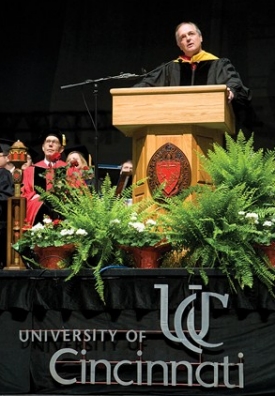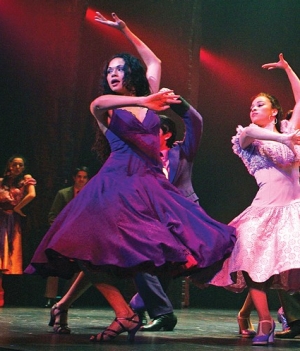Medical Breakthroughs
Understanding stroke
UC's neurology department won a $6.8 million NIH grant renewal to help thousands of patients who suffer from stroke and transient ischemic attacks (TIA). Founded in 1993 at the College of Medicine, the Greater Cincinnati/Northern Kentucky Stroke Team identifies all hospitalized and autopsied cases of stroke and TIA in a five-county region to help better understand the causes of stroke and its prevalence in Greater Cincinnati. Furthermore, UC's College of Allied Health Sciences has partnered with Drake Center to use a navigated-brain-stimulation device to guide patient treatment after a stroke. The team is analyzing the brain's ability to transmit high-quality signals to a patient's muscles in an effort to better predict the success of physical therapy during post-stroke rehabilitation.
Hungry? Blame food fat
UC obesity researchers say hunger hormones are activated by fats from the foods we eat -- not those produced in the body. The new findings, published in June, refute the predominant thinking about hunger hormones and point instead to a novel stomach enzyme that could be targeted in future treatments for metabolic diseases.
Predicting cancer outcome
UC environmental health scientists have identified a new biomarker they say could help predict a person's risk of developing colon cancer and how aggressive it becomes. The team identified areas of genetic data deletion that play a critical role in regulating gene expression and influence colon cancer progression. Researchers speculate that these "hotspots" could be used as a biomarker for colon cancer. In addition, UC cancer and cell biologists have identified a promising new molecular pathway key to the development of invasive prostate cancers. They hope their findings about two specific genes (PTEN and Par-4) will provide a clear molecular target to help guide development of new drugs to treat prostate cancer without harming the patient.
100 years," says neurosurgery professor John Tew, who performed the surgery at University Hospital with a seven-member team from the Brain Tumor Center at the UC Neuroscience Institute, where Tew is the clinical director.
3-D brain map
UC neurosurgeons and radiologists fused four different types of radiologic images into a 3-D map of the brain to successfully remove a fist-sized tumor from the brain of an Indiana woman this summer. "This marks the culmination of one of the most important developments in brain tumor surgery in the last 100 years," says neurosurgery professor John Tew, who performed the surgery at University Hospital with a seven-member team from the Brain Tumor Center at the UC Neuroscience Institute, where Tew is the clinical director.
Bench to bedside
Enhancing its status as a premier research institution, UC received an elite $23 million National Institutes of Health (NIH) grant aimed at bringing innovations from the laboratory bench to the bedside. The award was given to support programming within UC's Center for Clinical and Translational Science and Training, a collaboration with Cincinnati Children's Hospital Medical Center, University Hospital and the Cincinnati Department of Veterans Affairs Medical Center.
Fashionable hospital gown
Among hundreds of original garments being modeled at the annual College of Design, Architecture, Art, and Planning fashion show in June were a wide range of gowns -- everything from evening gowns to hospital gowns that can be worn with dignity.
University faculty and students, in partnership with Hill-Rom Co., a hospital-bed and medical-equipment maker, designed the hospital gowns in a variety of styles to accommodate various medical conditions. All are functional, comfortable, cost effective, easily donned, durable and less "breezy" than standard-issue gowns. Student also designed accessories, including a scarf with pockets, arm warmers, leg warmers and a shawl wrap.
Hill-Rom will spend about one year conducting research on manufacturing, marketing and demand. One day, the product line could possibly be available online, in hospital gift shops or via pre-orders prior to hospital stays.
DAAP students win design competition
UC students in the College of Design, Architecture, Art, and Planning have a lot to build on: They took home nearly every award in the 2009 Lyceum Fellowship architectural design competition, arguably the world's most prestigious student contest in the field. UC graduate architecture student Caity Osborn took top prize, winning $12,000 to fund five months of travel. In total, UC won seven out of 10 awards, including five of six merit awards.
This isn't the first time UC cleaned up in the competition, either -- in 2006, UC architecture students received five of the six awards given.
"I have never seen a school essentially sweep the competition twice, as the University of Cincinnati has now done," said Jon McKee, chair and founder of the Lyceum Fellowship Committee. "And this contest has been held for 24 years."
$5 million in gifts, grants
$2 million for Catholic studies -- The Ruth and Robert Conway Foundation gave UC's McMicken College of Arts and Sciences $2 million to establish a chair in Catholic studies. The gift will allow for the study of Catholicism's role in shaping secular disciplines for the last 2,000 years. The Conways' donation supports one of UC's "Proudly Cincinnati" campaign goals, which is the advancement of great teaching.
$3 million for biomedical technology -- UC has received $3 million from the state of Ohio to develop and market laser-shock peening (LSP), a technology that fights fatigue in the materials used to create biomedical devices, such as the titanium alloy rods used in spinal implant devices. LSP was first used in aviation, where it increases the reliability and lifespan of the titanium alloy found in aircraft turbine engines.
Vijay Vasudevan, a professor in the College of Engineering, is leading the project and hopes the technology will eventually lead to the manufacture of new, high-value biomedical devices in Ohio, creating jobs and economic growth.
Does UC stand for 'up and coming'?
U.S. News & World Report is the latest publication to describe UC as “up-and-coming.” The magazine’s annual “America’s Best Colleges” issue recently declared UC among 18 “up-and-coming” schools on the National Universities list. The U.S. News recognition was preceded by The Chronicle of Higher Education, which in July named UC among five "up-and-coming" universities.
Princeton Review raves about UC
Naming the university as one of the nation's best undergraduate institutions for the third consecutive year, the Princeton Review listed UC in its 2010 guidebook of best colleges. Only 15 percent of the nation's four-year colleges are profiled in the annual guide, which called UC an urban university in the midst of a renaissance and highlighted the campus's diversity.
Partnering for a healthier Cincinnati
The University of Cincinnati, UC Physicians and University Hospital have partnered to form UC Health, a collaboration that brings together the Tri-state's largest group of specialists with the area's premier teaching hospital and trauma center.
Together, the partnership will comprise more than 659 clinicians, a 650-bed hospital, 20 clinical locations across the region and a medical campus in West Chester, Ohio. University Hospital and UC Physicians provide care to more than 600,000 patients each year.
David Stern, College of Medicine dean and vice president for health affairs, says UC Health has stemmed from strategic planning among the hospital, medical college and physician practice already in place.
"UC health is more than just a new name," says Stern. "It will allow us to sustain and support a college of medicine, a faculty who teach, treat and discover, and a hospital that takes on the toughest cases and succeeds. Our progress has been and will be essential to our status as a great city."
Lee Ann Liska, executive director of University Hospital, says the partnerships represents a re-dedication to the longstanding relationship between the facility and UC, and is "built on a commitment to the community, medical 'firsts' and a tradition of quality."
Handing over more Habitat keys
The University of Cincinnati, partnering with Cincinnati Habitat for Humanity, handed over its sixth set of house keys to a local family who could have never purchased a home on their own.
The partnership helped TyAnn Edwards and her teenage son, Dwight Williams, move into a brand new home in Avondale in 2009. Just as in previous years, UC committed to funding and supplying volunteers to build the home, while Edwards' family invested 500 hours of sweat equity and is purchasing the home with a 25-year interest-free mortgage. UC student ingenuity also helped equip the home to accommodate Edwards' wheelchair, which she's needed since being paralyzed in a car accident. The Edwards family is pictured with Tom Salzbrun, Cincinnati Habitat's executive director, and Helen Spieler, family services manager.
Expanding benefits for veterans
The university has expanded college tuition benefits for qualifying veterans, specifically post-9/11 service men and women.
UC is taking part in a new federal Yellow Ribbon program that expands the existing GI Bill, which pays a portion of undergraduate tuition, and clears the way for qualifying vets who need assistance to attend graduate and professional schools such as law and medicine.
Provost Anthony Perzigian says this is one more step by UC to lead the state among four-year public insitutions in opportunities for veterans. The university now accommodates up to 50 such students a year, half of who are enrolled in grad programs.

 Issue Archive
Issue Archive


